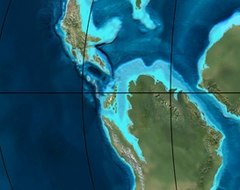Caballos Formation
| Caballos Formation | |
|---|---|
| Stratigraphic range: Aptian-Albian ~ | |
| Type | Geological formation |
| Underlies | Hondita Formation |
| Overlies | Yaví Fm., Saldaña Fm. |
| Thickness | up to 411 m (1,348 ft) |
| Lithology | |
| Primary | Sandstone, shale, siltstone |
| Other | Limestone, coal |
| Location | |
| Coordinates | 3°49′18.9″N 75°21′22.4″W / 3.821917°N 75.356222°W |
| Region | VSM & Caguán-Putumayo Basin Central & Eastern Ranges, Andes |
| Country | |
| Type section | |
| Named for | Cerro Caballos |
| Named by | Corrigan |
| Location | Olaya Herrera |
| Year defined | 1967 |
| Coordinates | 3°49′18.9″N 75°21′22.4″W / 3.821917°N 75.356222°W |
| Approximate paleocoordinates | 2°54′S 47°24′W / 2.9°S 47.4°W |
| Region | Tolima |
| Country | |
| Thickness at type section | 411 m (1,348 ft) |
 Paleogeography of Northern South America 105 Ma, by Ron Blakey | |
The Caballos Formation (Spanish: Formación Caballos, KI) is a geological formation of the Upper Magdalena Valley (VSM), Caguán-Putumayo Basin, Central and Eastern Ranges of the Colombian Andes. The sandstone and shale formation dates to the Middle Cretaceous period; Aptian to Albian epochs and has a maximum thickness of 411 metres (1,348 ft).
Etymology
The formation was defined and named in 1967 by Corrigan after Cerro Caballos, to the west of Olaya Herrera, Tolima.[1]
Description
Lithologies
The Caballos Formation has a maximum thickness of 411 metres (1,348 ft) in the Quebrada Bambucá and is characterized by a lower sequence of fine to coarse sandstones, of lithic arenite, quartz arenite and feldspar arenite composition, a middle section of fossiliferous black shales and siltstones, intercalated by micritic limestones and coals and very fine sandstones. The upper part of the formation contains conglomerates and glauconitic sandstones.[1]
Stratigraphy and depositional environment
The Caballos Formation in some parts concordantly overlies the Yaví Formation and in other parts rests unconformably on the Saldaña Formation and Ibagué Batholith.[2] The formation is overlain by the Hondita Formation. The age has been estimated to be Aptian to Albian. Stratigraphically, the formation is time equivalent with the Une, Aguardiente, Simijaca, El Peñón, Capotes, Tablazo, Tibú-Mercedes and Pacho Formations.[3] The formation has been deposited in a fluvial to estuarine and shallow marine environment.[4]
The Caballos Formation is a source, reservoir and seal rock in the Upper Magdalena Valley,[5][6] and a source and reservoir rock in the Caguán-Putumayo Basin.[7][8] The Orito and Moqueta Fields of the latter basin produce from Caballos reservoirs.
Fossil content
The formation has provided fossils of Heminautilus etheringtoni,[9] Araucarites sp., Brachyphyllum sp., Cladophlebis sp., and Weichselia sp.,[10] as well as many types of pollen.[11]
Outcrops
The Caballos Formation is apart from its type locality, found in Huila, Tolima and Putumayo Departments.
See also
- List of fossiliferous stratigraphic units in Colombia
- Geology of the Eastern Hills
- Geology of the Altiplano Cundiboyacense
References
- ^ a b Velandia et al., 2001, p.53
- ^ Velandia et al., 2001, p.34
- ^ Velandia et al., 2001, p.54
- ^ Villamil, 2012, p.166
- ^ ANH, 2007, p.84
- ^ García González et al., 2009, p.83
- ^ ANH, 2007, p.57
- ^ García González et al., 2009, p.16
- ^ Badouin et al., 2016, p.87
- ^ Monje et al., 2016, p.38
- ^ Los Mangos at Fossilworks.org
Bibliography
- Template:Cite LSA
- Template:Cite LSA
- Template:Cite LSA
- Template:Cite LSA
- Template:Cite LSA
- Template:Cite LSA
- Template:Cite LSA
Maps
- Template:Cite LSA
- Template:Cite LSA
- Template:Cite LSA
- Template:Cite LSA
- Template:Cite LSA
- Template:Cite LSA
- Template:Cite LSA
- Template:Cite LSA
- Template:Cite LSA
- Template:Cite LSA
- Template:Cite LSA
- Template:Cite LSA
- Template:Cite LSA
- Template:Cite LSA
- Template:Cite LSA
- Template:Cite LSA
- Template:Cite LSA
- Template:Cite LSA
- Template:Cite LSA
- Template:Cite LSA
- Template:Cite LSA
- Template:Cite LSA
- Template:Cite LSA
- Template:Cite LSA
- Geologic formations of Colombia
- Cretaceous Colombia
- Lower Cretaceous Series of South America
- Albian Stage
- Aptian Stage
- Sandstone formations
- Shale formations
- Siltstone formations
- Limestone formations
- Coal formations
- Fluvial deposits
- Shallow marine deposits
- Source rock formations
- Reservoir rock formations
- Seal rock formations
- Fossiliferous stratigraphic units of South America
- Paleontology in Colombia
- Geography of Huila Department
- Geography of Putumayo Department
- Geography of Tolima Department

